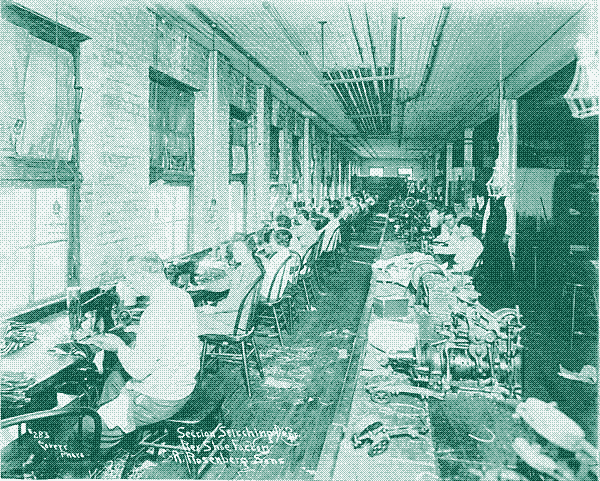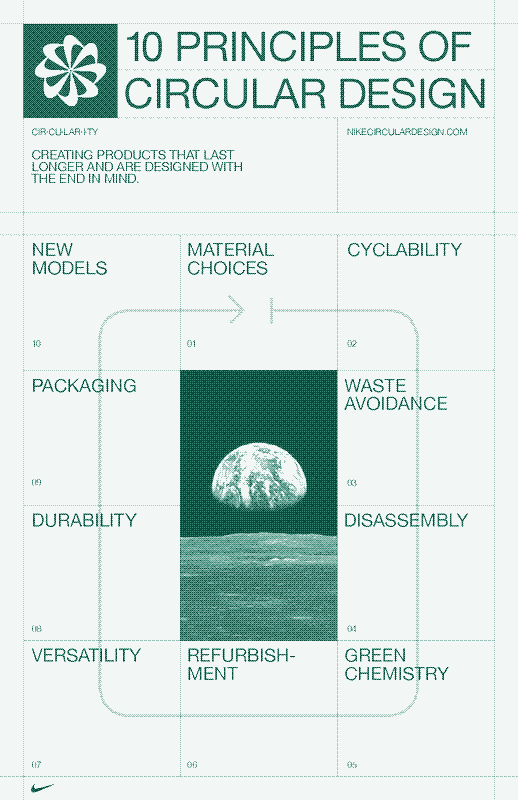
an image of workers in the stitching department, Mr. Covert, Public domain, via Wikimedia Commons
table of contents
The evolution of alienation and ideas on how to tackle it
In 1844 Karl Marx first wrote about his theory of alienation, stating that people were losing their connection to the work they were doing, because they were only completing one small subtask and not seeing their end results.
In 1945 B. F. Skinner published his novel “Walden Two”, exploring the concept of living in smaller communes, in order to reinstate this connection on one’s influence on the world and surroundings.
This essay aims to find out how the two texts are still relevant today and how they compare to the modern idea of “circular design”.
First, I will compare the two texts in showing similarities and dissonances. Then I will attempt bridging the gap to today, especially the much discussed term of circular design.
Now more than ever, designers are facing the challenges of pollution, over-production and resources becoming ever more scarce. To tackle this topic is in a first instance to consciously see the effect one has as a buyer/user, as a company and as a designer on one’s surrounding. In other words, the goal is to try looking at the work one does and seeing the effect one has on all other parts of a system, be that socially, economically or ecologically. This topic of losing connection from one’s work when only executing one sub-task, or not seeing one’s effect on one’s environment has existed for a very long time and has been discussed by philosophers, politicians and scientists alike.
By comparing Karl Marx’s “Economic Philosophic Manuscript” with B. F. Skinner’s “Walden Two”, representing two major ways of thinking over the last 200 years, I will show how the discussion of alienation has persisted but the ideas of how to best tackle the problem have undergone significant changes. Furthermore, I will bridge the gap to today and analyze how the two texts compare to the modern philosophy of circular design.
In his 1844 “Economic Philosophic Manuscripts”, Karl Marx first formulated the theory of alienation (Entfremdung), stating that people were gradually becoming estranged from their human nature (Gattungswesen).
Marx looks at alienation from three main perspectives:
Firstly he talks about alienation from the product, where the main problem is that the decision over design and means of production no longer lie in the hands of the people that produce (the workers), but in the hands of the capitalist class. Additionally, Entfremdung from the product is the process of work as a means of producing goods getting transformed into a commodity, allowing work to be traded just like products.
The second kind of alienation Marx talks about in his treatise is the alienation from the act of production. Here he states that the disconnect between the worker and the work he does leads to great unhappiness. In his eyes there are two ways a worker is estranged from the act of production, namely: wage compulsion and the imposed production content.
The state (with taxes) and the workers’ will to survive force them to sell their work in order to earn money with which to buy survival needs. Therefore work is not voluntary and bound to the dictate of the capitalist that hires a worker.
Seen as the worker is not the one deciding what, why and in what way he works or produces, his work is tied to his salary alone, production content, direction and form are imposed by the capitalist. This restrains the worker from developing freely and finding joy in their work that is viewed as external and impersonal.
Alienation for Marx is tied very closely to the term of Gattungswesen or ‘species-essence’. In the philosopher’s view, a person’s consciousness does not form individually but inter-subjectively, depending on the people they surround themselves with and on the things that facilitate survival, most importantly cooperation.
Though inter-subjective, the species-essence is very personal in a sense that every person aims to spend time in literature, art and cultural heritage in a way that fits them in their abilities, i.e. one who paints likes to spend time painting for the sake of painting rather than it being on assignment by a capitalist.
Almost exactly a century later, in 1945, Burrhus Frederic Skinner writes, in his fictional novel “Walden Two”, on a new form of organizing society following the theory of behaviourism and adapting the principle of reinforcement in smaller groups, so as to allow individuals to more easily see the effect of their doings on the people and nature around them.
The novel revolves around professor Burris and one of his former students that contacts him regarding a new form of organizing society. Professor Burris remembers one of his classmates, Frazier, that used to imagine exactly that and contacts him. Subsequently, Burris and Rogers, the former student, together with a few friends, go visit so-called “Futurum Two”, the commune formed by Frazier.
For this text, I will focus mainly on the introduction that was added by the author in 1972. There, he writes that his novel became increasingly relevant as technology and the field of behaviourism advanced in almost exactly the direction he had imagined in it.
Evermore people became aware of advances in the field of behaviourism and behaviour modification.
Skinner was convinced that free will did not exist and formulated his theory of reinforcement whereafter actions and their consequences, be they good or bad, influenced human behaviour and our decisions.
One of the most prominent instances which give people feedback are the people surrounding them. This leads to his conception of people wanting to be an integrated part of a community, where they can work on the terms of the common goal on the topics that interest them the most.
Skinner further states that we do very little in our society to effectively promote individuality. For example, instead of putting children into classes where everyone learns the same curriculum and in the same way of teaching, in a smaller commune one would have the opportunity to individually support and nurture children based on their interests and capabilities.
In 2012, Ellen MacArthur launched the “Ellen MacArthur Foundation” that has set their goal to be the promotion of a circular design approach and a circular economy and showing what effect this has on economy and growth. The basic idea is to promote the creation of an economy, where, from the beginning, the material, life-cycle and re-use or end of the product are thought through, designed. In this way, waste is reduced or potentially even cut, thanks to reusing raw materials or choosing materials that regrow and disintegrate in a fitting time-frame.
Nike have also made efforts to become more circular in their processes and have published their 10 principles of circular design, shown in the image below.

the title page of nike’s mini-guide, source: https://circulardesign.nike.com/guides/MiniGuide.pdf
Looking at the texts, it becomes apparent that all three agree on there being an alienation from work in the sense that people have become detached from their work and effect on their surroundings. Interestingly the focus of the effect of said alienation has shifted. Where Marx stated that the discrepancy between work and worker affecting the person negatively by stripping them of their Gattungswesen, wanting to be creative and form their surroundings, Skinner focused more on the negative effect on our society of people not having to face the consequences of their actions. All agree that it is important to people to have purpose in their life Skinner’s solution is much less radical, wanting to change but the organisational structures of a society in order to more directly have feedback as a person for what one does, rather than changing the whole monetary and societal system. Even less change gets demanded by modern circular design thinking, where the goal is to solely adapt processes and think more circularly, while keeping societal structures.
references
Texts
- Marx, Karl (1844). Economic Philosophic Manuscripts (corrected 2009). Moscow: Progress Publishers. https://www.marxists.org/archive/marx/works/download/pdf/Economic-Philosophic-Manuscripts-1844.pdf
- Skinner, B.F. (1948). Walden Two. Indianapolis: Hackett Publishing Company.
Images
- Image 1: 10 Principles of circular design. Page 1. nikecirculardesign.com https://www.nikecirculardesign.com/guides/MiniGuide.pdf